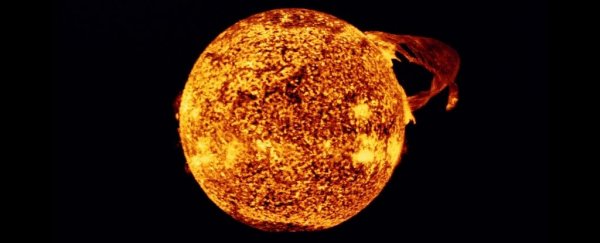Deep beneath the ice in Greenland and Antarctica, researchers have found signs of an enormous solar 'tsunami' that once crashed against Earth's atmosphere more than 9,000 years ago.
This ancient superstorm was triggered by a wave of hot plasma and magnetism from the Sun, and it is significantly larger than anything we have recorded in recent history.
The findings have got scientists concerned about our ability to predict when the Sun is going to let loose next.
Solar storms on Earth occur every few years, when the Sun's activity is at a peak, but this ancient superstorm is on a whole other scale, and it appears to have struck during a quiet phase of the solar cycle.
In recent years, scientists have warned that we are wholly unprepared for a solar storm of this size. Experts still haven't figured out how to predict these rare yet disastrous events, and the infrastructure we have built today is exceptionally vulnerable to geomagnetic fallout.
If one of these superstorms were to strike tomorrow, it could impact satellites and astronauts in orbit, as well as air traffic control, electricity grids, and undersea cables, triggering travel limits, blackouts and global internet outages that could last for months.
Just consider what happened in 1859, when we had way less infrastructure at stake. The Carrington Event was a solar storm so severe, it collapsed telegraph systems in Europe and North America, while also triggering auroras right across the world, from Australia to Hawaii to China to Mexico.
But what happened 9,000 years ago could give that notorious event a run for its money.
A solar flare or a coronal mass ejection is what usually triggers a solar storm. The latter occurs when the Sun belches out roughly a billion tonnes of energetic particles into space, and if the burp is big enough, these particles can hit Earth's atmosphere in as little as 15 hours.
The reaction produces several radioactive nuclides, such as carbon-14, beryllium-10, and chlorine-36.
Traces of these distinct isotopes, frozen in ice or trapped in sediment, can therefore help us elucidate the history of extreme solar events on Earth, so we can better understand how often they occur.
The recent ice cores analyzed from Greenland and Antarctica have now revealed some of the largest beryllium-10 and chlorine-36 production peaks ever detected in Earth's distant past.
The evidence strongly suggests there was an extreme solar storm about 9,125 years before the present.
"This is time-consuming and expensive analytical work," says geologist Raimund Muscheler from Lund University in Sweden.
"Therefore, we were pleasantly surprised when we found such a peak, indicating a hitherto unknown giant solar storm in connection with low solar activity."
Judging by the ratio of chlorine-36 to beryllium-10 isotopes, this event may even have been larger than the largest solar storm recorded to date in other ice cores and tree rings, dated to the year 774.
Both of these prehistoric storms were much larger than anything we have seen since the 1950s, "thus implying a so far underestimated threat to our society", according to the authors of the paper.
"These enormous storms are currently not sufficiently included in risk assessments," says Muscheler.
"It is of the utmost importance to analyze what these events could mean for today's technology and how we can protect ourselves."
Otherwise, the Sun could catch us wholly unprepared.
The study was published in Nature Communications.
